Inventory Management With Auctions
VerifiedAdded on 2022/09/02
|17
|4233
|21
AI Summary
Contribute Materials
Your contribution can guide someone’s learning journey. Share your
documents today.
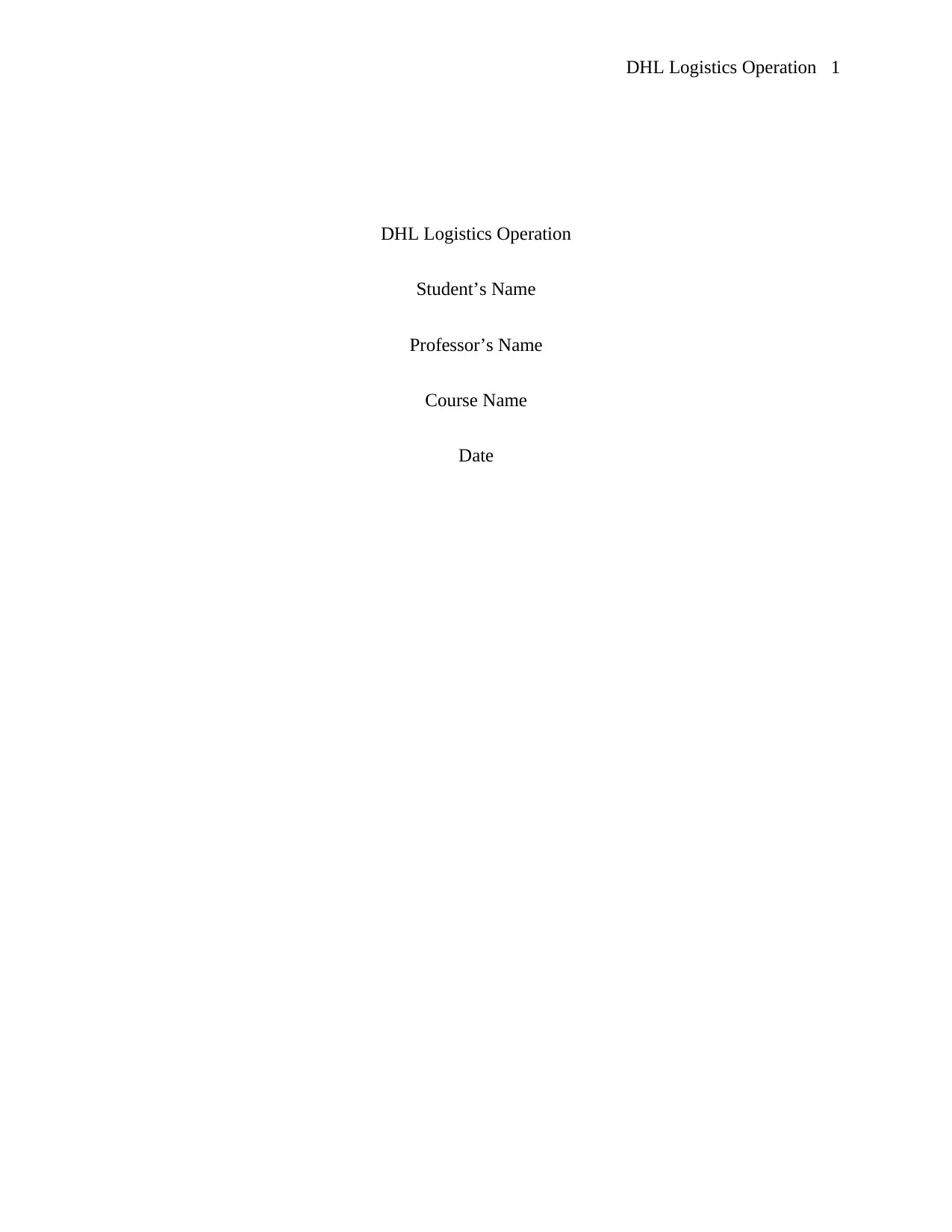
DHL Logistics Operation 1
DHL Logistics Operation
Student’s Name
Professor’s Name
Course Name
Date
DHL Logistics Operation
Student’s Name
Professor’s Name
Course Name
Date
Secure Best Marks with AI Grader
Need help grading? Try our AI Grader for instant feedback on your assignments.
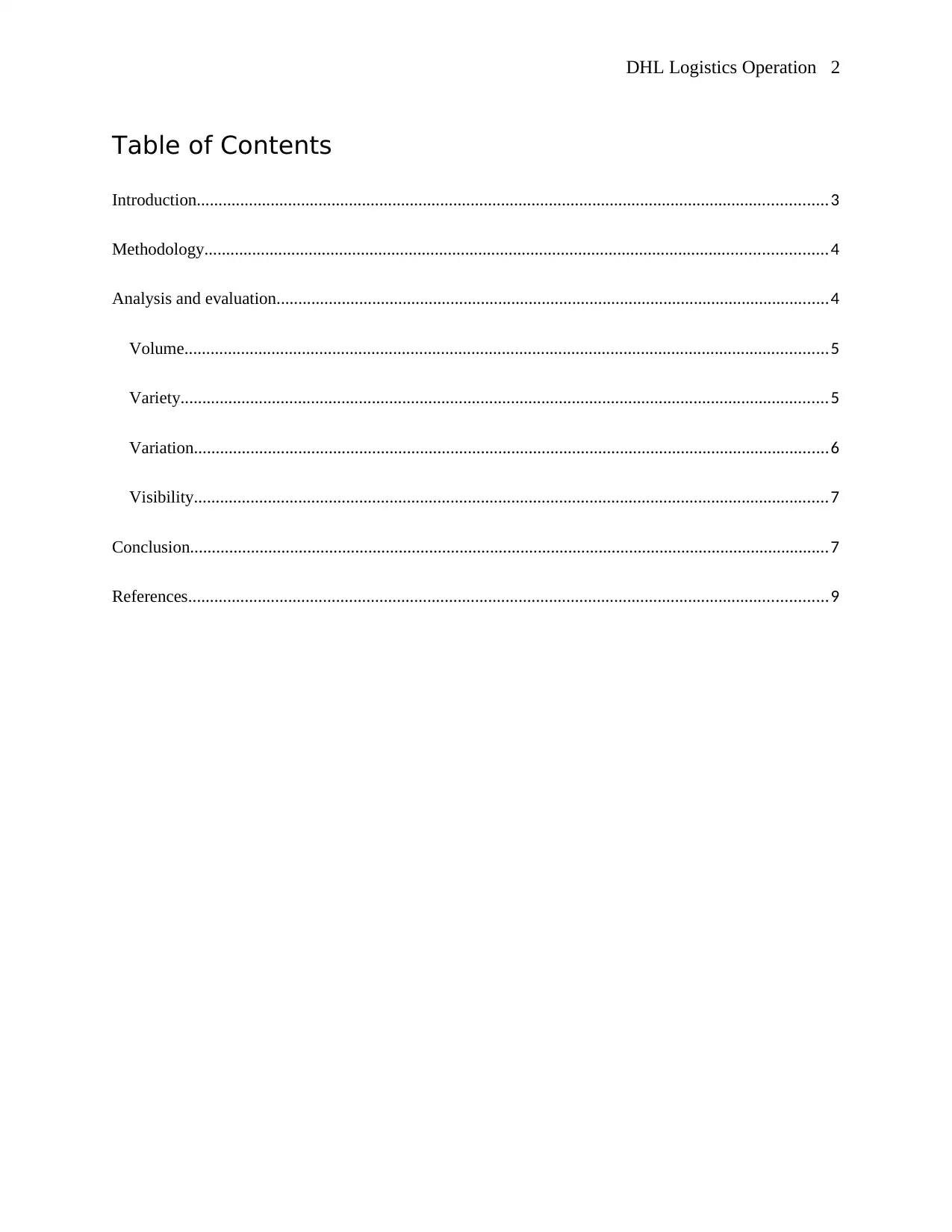
DHL Logistics Operation 2
Table of Contents
Introduction.................................................................................................................................................3
Methodology...............................................................................................................................................4
Analysis and evaluation...............................................................................................................................4
Volume....................................................................................................................................................5
Variety.....................................................................................................................................................5
Variation..................................................................................................................................................6
Visibility..................................................................................................................................................7
Conclusion...................................................................................................................................................7
References...................................................................................................................................................9
Table of Contents
Introduction.................................................................................................................................................3
Methodology...............................................................................................................................................4
Analysis and evaluation...............................................................................................................................4
Volume....................................................................................................................................................5
Variety.....................................................................................................................................................5
Variation..................................................................................................................................................6
Visibility..................................................................................................................................................7
Conclusion...................................................................................................................................................7
References...................................................................................................................................................9
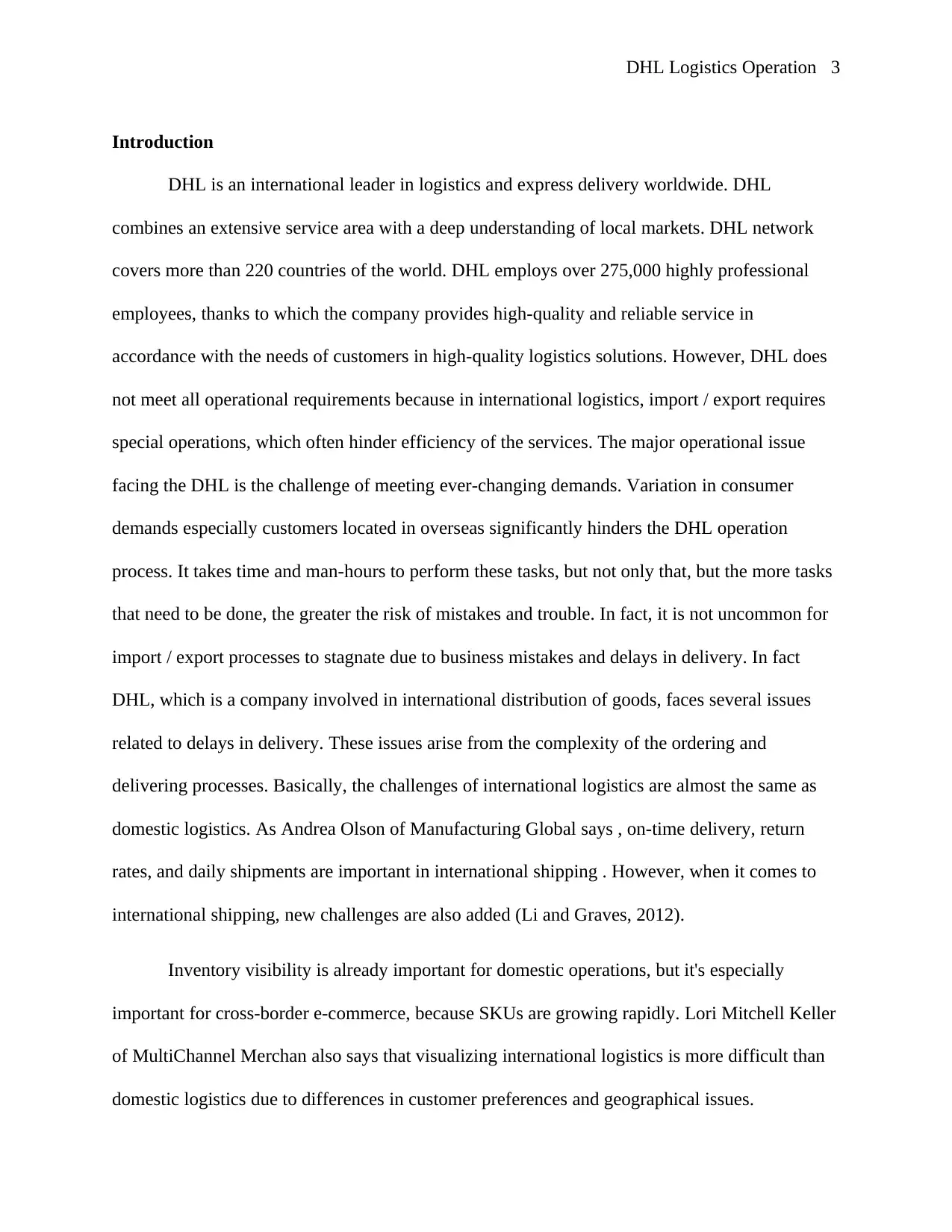
DHL Logistics Operation 3
Introduction
DHL is an international leader in logistics and express delivery worldwide. DHL
combines an extensive service area with a deep understanding of local markets. DHL network
covers more than 220 countries of the world. DHL employs over 275,000 highly professional
employees, thanks to which the company provides high-quality and reliable service in
accordance with the needs of customers in high-quality logistics solutions. However, DHL does
not meet all operational requirements because in international logistics, import / export requires
special operations, which often hinder efficiency of the services. The major operational issue
facing the DHL is the challenge of meeting ever-changing demands. Variation in consumer
demands especially customers located in overseas significantly hinders the DHL operation
process. It takes time and man-hours to perform these tasks, but not only that, but the more tasks
that need to be done, the greater the risk of mistakes and trouble. In fact, it is not uncommon for
import / export processes to stagnate due to business mistakes and delays in delivery. In fact
DHL, which is a company involved in international distribution of goods, faces several issues
related to delays in delivery. These issues arise from the complexity of the ordering and
delivering processes. Basically, the challenges of international logistics are almost the same as
domestic logistics. As Andrea Olson of Manufacturing Global says , on-time delivery, return
rates, and daily shipments are important in international shipping . However, when it comes to
international shipping, new challenges are also added (Li and Graves, 2012).
Inventory visibility is already important for domestic operations, but it's especially
important for cross-border e-commerce, because SKUs are growing rapidly. Lori Mitchell Keller
of MultiChannel Merchan also says that visualizing international logistics is more difficult than
domestic logistics due to differences in customer preferences and geographical issues.
Introduction
DHL is an international leader in logistics and express delivery worldwide. DHL
combines an extensive service area with a deep understanding of local markets. DHL network
covers more than 220 countries of the world. DHL employs over 275,000 highly professional
employees, thanks to which the company provides high-quality and reliable service in
accordance with the needs of customers in high-quality logistics solutions. However, DHL does
not meet all operational requirements because in international logistics, import / export requires
special operations, which often hinder efficiency of the services. The major operational issue
facing the DHL is the challenge of meeting ever-changing demands. Variation in consumer
demands especially customers located in overseas significantly hinders the DHL operation
process. It takes time and man-hours to perform these tasks, but not only that, but the more tasks
that need to be done, the greater the risk of mistakes and trouble. In fact, it is not uncommon for
import / export processes to stagnate due to business mistakes and delays in delivery. In fact
DHL, which is a company involved in international distribution of goods, faces several issues
related to delays in delivery. These issues arise from the complexity of the ordering and
delivering processes. Basically, the challenges of international logistics are almost the same as
domestic logistics. As Andrea Olson of Manufacturing Global says , on-time delivery, return
rates, and daily shipments are important in international shipping . However, when it comes to
international shipping, new challenges are also added (Li and Graves, 2012).
Inventory visibility is already important for domestic operations, but it's especially
important for cross-border e-commerce, because SKUs are growing rapidly. Lori Mitchell Keller
of MultiChannel Merchan also says that visualizing international logistics is more difficult than
domestic logistics due to differences in customer preferences and geographical issues.
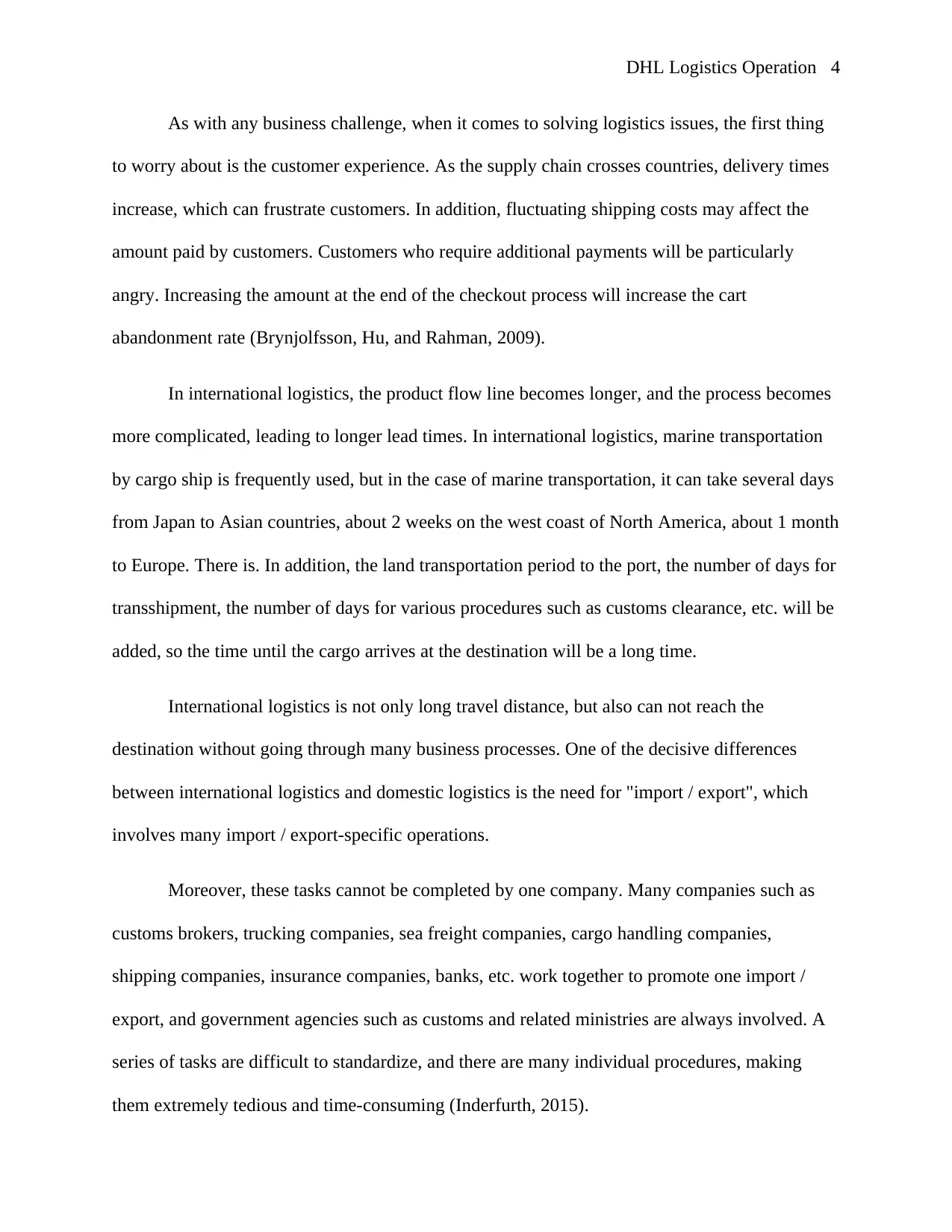
DHL Logistics Operation 4
As with any business challenge, when it comes to solving logistics issues, the first thing
to worry about is the customer experience. As the supply chain crosses countries, delivery times
increase, which can frustrate customers. In addition, fluctuating shipping costs may affect the
amount paid by customers. Customers who require additional payments will be particularly
angry. Increasing the amount at the end of the checkout process will increase the cart
abandonment rate (Brynjolfsson, Hu, and Rahman, 2009).
In international logistics, the product flow line becomes longer, and the process becomes
more complicated, leading to longer lead times. In international logistics, marine transportation
by cargo ship is frequently used, but in the case of marine transportation, it can take several days
from Japan to Asian countries, about 2 weeks on the west coast of North America, about 1 month
to Europe. There is. In addition, the land transportation period to the port, the number of days for
transshipment, the number of days for various procedures such as customs clearance, etc. will be
added, so the time until the cargo arrives at the destination will be a long time.
International logistics is not only long travel distance, but also can not reach the
destination without going through many business processes. One of the decisive differences
between international logistics and domestic logistics is the need for "import / export", which
involves many import / export-specific operations.
Moreover, these tasks cannot be completed by one company. Many companies such as
customs brokers, trucking companies, sea freight companies, cargo handling companies,
shipping companies, insurance companies, banks, etc. work together to promote one import /
export, and government agencies such as customs and related ministries are always involved. A
series of tasks are difficult to standardize, and there are many individual procedures, making
them extremely tedious and time-consuming (Inderfurth, 2015).
As with any business challenge, when it comes to solving logistics issues, the first thing
to worry about is the customer experience. As the supply chain crosses countries, delivery times
increase, which can frustrate customers. In addition, fluctuating shipping costs may affect the
amount paid by customers. Customers who require additional payments will be particularly
angry. Increasing the amount at the end of the checkout process will increase the cart
abandonment rate (Brynjolfsson, Hu, and Rahman, 2009).
In international logistics, the product flow line becomes longer, and the process becomes
more complicated, leading to longer lead times. In international logistics, marine transportation
by cargo ship is frequently used, but in the case of marine transportation, it can take several days
from Japan to Asian countries, about 2 weeks on the west coast of North America, about 1 month
to Europe. There is. In addition, the land transportation period to the port, the number of days for
transshipment, the number of days for various procedures such as customs clearance, etc. will be
added, so the time until the cargo arrives at the destination will be a long time.
International logistics is not only long travel distance, but also can not reach the
destination without going through many business processes. One of the decisive differences
between international logistics and domestic logistics is the need for "import / export", which
involves many import / export-specific operations.
Moreover, these tasks cannot be completed by one company. Many companies such as
customs brokers, trucking companies, sea freight companies, cargo handling companies,
shipping companies, insurance companies, banks, etc. work together to promote one import /
export, and government agencies such as customs and related ministries are always involved. A
series of tasks are difficult to standardize, and there are many individual procedures, making
them extremely tedious and time-consuming (Inderfurth, 2015).
Secure Best Marks with AI Grader
Need help grading? Try our AI Grader for instant feedback on your assignments.
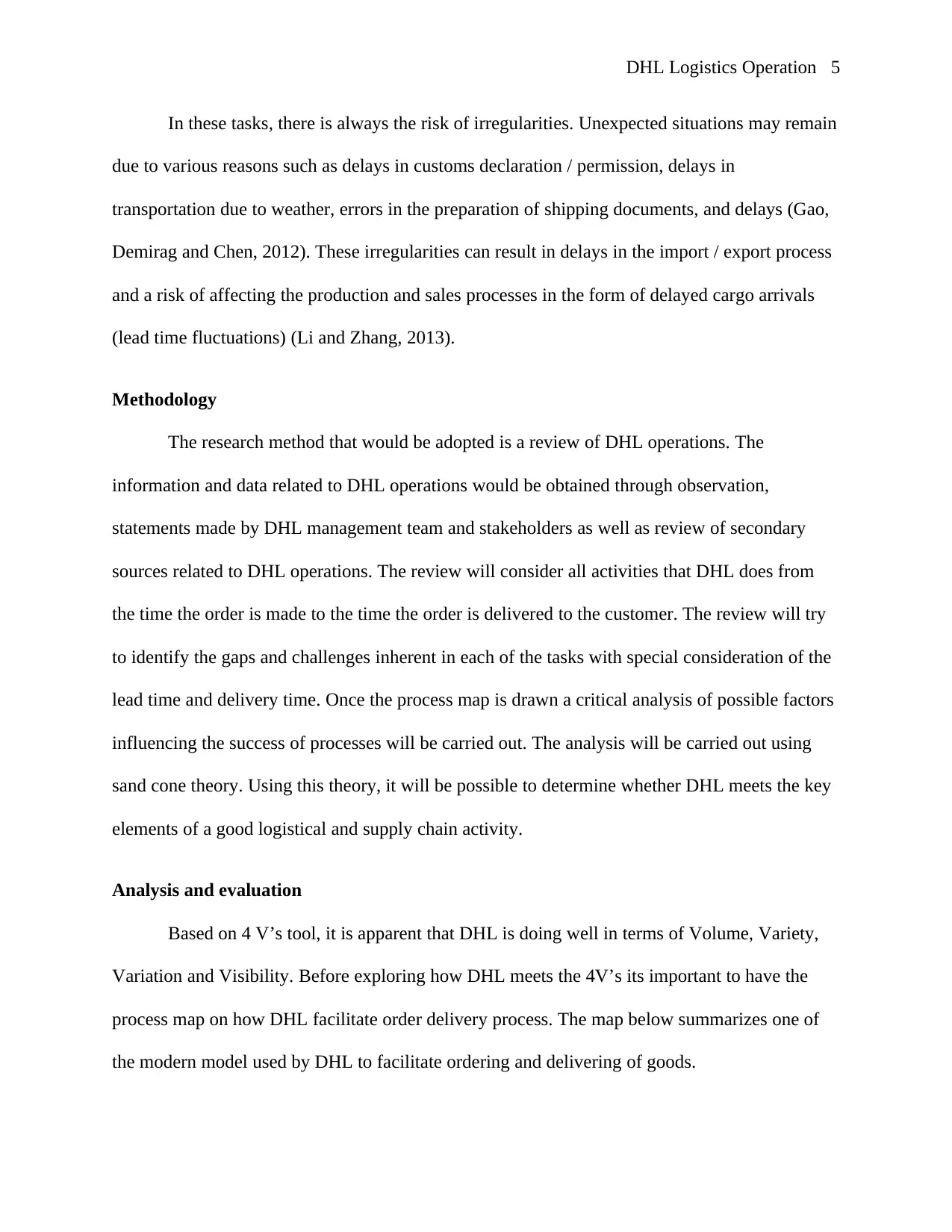
DHL Logistics Operation 5
In these tasks, there is always the risk of irregularities. Unexpected situations may remain
due to various reasons such as delays in customs declaration / permission, delays in
transportation due to weather, errors in the preparation of shipping documents, and delays (Gao,
Demirag and Chen, 2012). These irregularities can result in delays in the import / export process
and a risk of affecting the production and sales processes in the form of delayed cargo arrivals
(lead time fluctuations) (Li and Zhang, 2013).
Methodology
The research method that would be adopted is a review of DHL operations. The
information and data related to DHL operations would be obtained through observation,
statements made by DHL management team and stakeholders as well as review of secondary
sources related to DHL operations. The review will consider all activities that DHL does from
the time the order is made to the time the order is delivered to the customer. The review will try
to identify the gaps and challenges inherent in each of the tasks with special consideration of the
lead time and delivery time. Once the process map is drawn a critical analysis of possible factors
influencing the success of processes will be carried out. The analysis will be carried out using
sand cone theory. Using this theory, it will be possible to determine whether DHL meets the key
elements of a good logistical and supply chain activity.
Analysis and evaluation
Based on 4 V’s tool, it is apparent that DHL is doing well in terms of Volume, Variety,
Variation and Visibility. Before exploring how DHL meets the 4V’s its important to have the
process map on how DHL facilitate order delivery process. The map below summarizes one of
the modern model used by DHL to facilitate ordering and delivering of goods.
In these tasks, there is always the risk of irregularities. Unexpected situations may remain
due to various reasons such as delays in customs declaration / permission, delays in
transportation due to weather, errors in the preparation of shipping documents, and delays (Gao,
Demirag and Chen, 2012). These irregularities can result in delays in the import / export process
and a risk of affecting the production and sales processes in the form of delayed cargo arrivals
(lead time fluctuations) (Li and Zhang, 2013).
Methodology
The research method that would be adopted is a review of DHL operations. The
information and data related to DHL operations would be obtained through observation,
statements made by DHL management team and stakeholders as well as review of secondary
sources related to DHL operations. The review will consider all activities that DHL does from
the time the order is made to the time the order is delivered to the customer. The review will try
to identify the gaps and challenges inherent in each of the tasks with special consideration of the
lead time and delivery time. Once the process map is drawn a critical analysis of possible factors
influencing the success of processes will be carried out. The analysis will be carried out using
sand cone theory. Using this theory, it will be possible to determine whether DHL meets the key
elements of a good logistical and supply chain activity.
Analysis and evaluation
Based on 4 V’s tool, it is apparent that DHL is doing well in terms of Volume, Variety,
Variation and Visibility. Before exploring how DHL meets the 4V’s its important to have the
process map on how DHL facilitate order delivery process. The map below summarizes one of
the modern model used by DHL to facilitate ordering and delivering of goods.
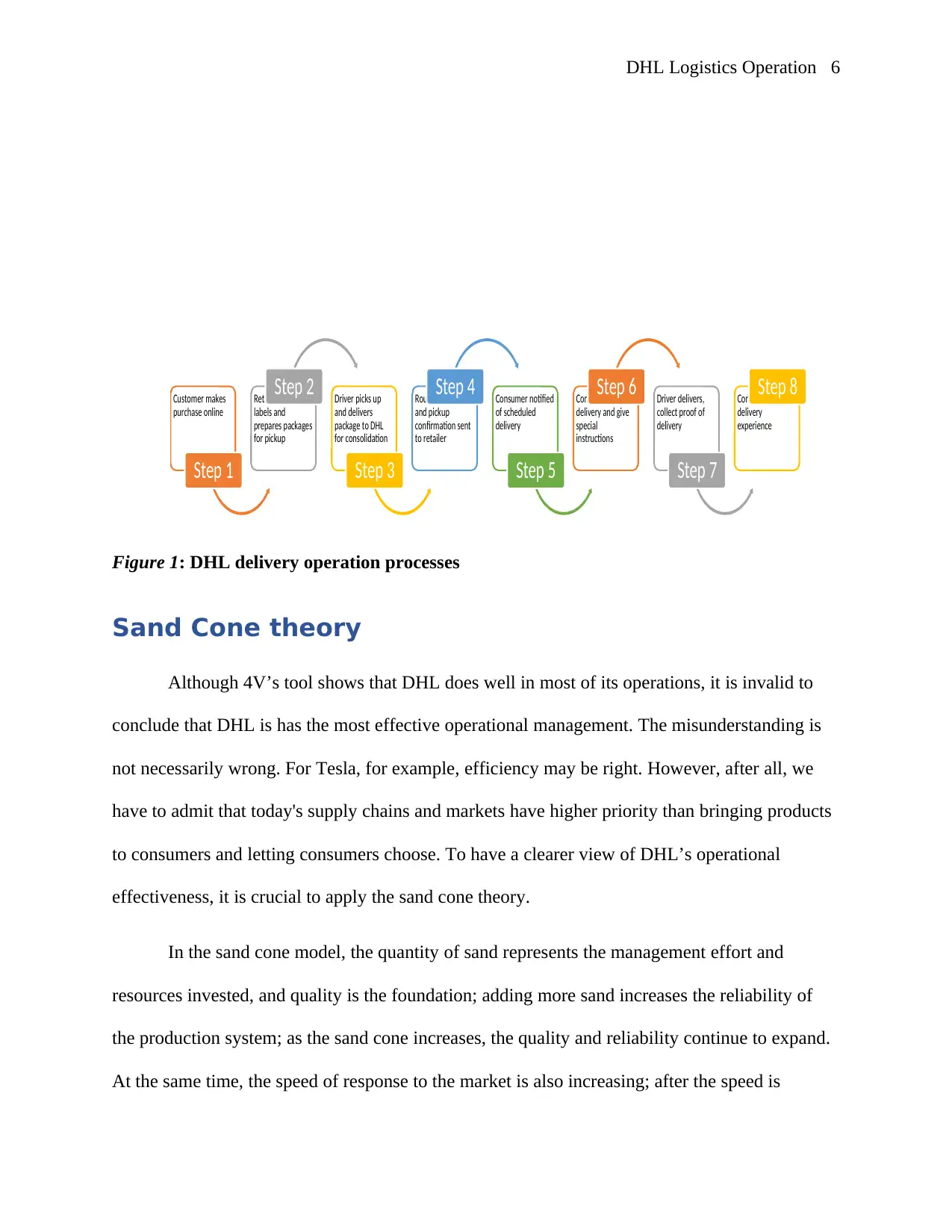
DHL Logistics Operation 6
Figure 1: DHL delivery operation processes
Sand Cone theory
Although 4V’s tool shows that DHL does well in most of its operations, it is invalid to
conclude that DHL is has the most effective operational management. The misunderstanding is
not necessarily wrong. For Tesla, for example, efficiency may be right. However, after all, we
have to admit that today's supply chains and markets have higher priority than bringing products
to consumers and letting consumers choose. To have a clearer view of DHL’s operational
effectiveness, it is crucial to apply the sand cone theory.
In the sand cone model, the quantity of sand represents the management effort and
resources invested, and quality is the foundation; adding more sand increases the reliability of
the production system; as the sand cone increases, the quality and reliability continue to expand.
At the same time, the speed of response to the market is also increasing; after the speed is
Customer makes
purchase online
Step 1
Retailer print
labels and
prepares packages
for pickup
Step 2 Driver picks up
and delivers
package to DHL
for consolidation
Step 3
Route assigned
and pickup
confirmation sent
to retailer
Step 4 Consumer notified
of scheduled
delivery
Step 5
Consumer tracks
delivery and give
special
instructions
Step 6 Driver delivers,
collect proof of
delivery
Step 7
Consumer can rae
delivery
experience
Step 8
Figure 1: DHL delivery operation processes
Sand Cone theory
Although 4V’s tool shows that DHL does well in most of its operations, it is invalid to
conclude that DHL is has the most effective operational management. The misunderstanding is
not necessarily wrong. For Tesla, for example, efficiency may be right. However, after all, we
have to admit that today's supply chains and markets have higher priority than bringing products
to consumers and letting consumers choose. To have a clearer view of DHL’s operational
effectiveness, it is crucial to apply the sand cone theory.
In the sand cone model, the quantity of sand represents the management effort and
resources invested, and quality is the foundation; adding more sand increases the reliability of
the production system; as the sand cone increases, the quality and reliability continue to expand.
At the same time, the speed of response to the market is also increasing; after the speed is
Customer makes
purchase online
Step 1
Retailer print
labels and
prepares packages
for pickup
Step 2 Driver picks up
and delivers
package to DHL
for consolidation
Step 3
Route assigned
and pickup
confirmation sent
to retailer
Step 4 Consumer notified
of scheduled
delivery
Step 5
Consumer tracks
delivery and give
special
instructions
Step 6 Driver delivers,
collect proof of
delivery
Step 7
Consumer can rae
delivery
experience
Step 8
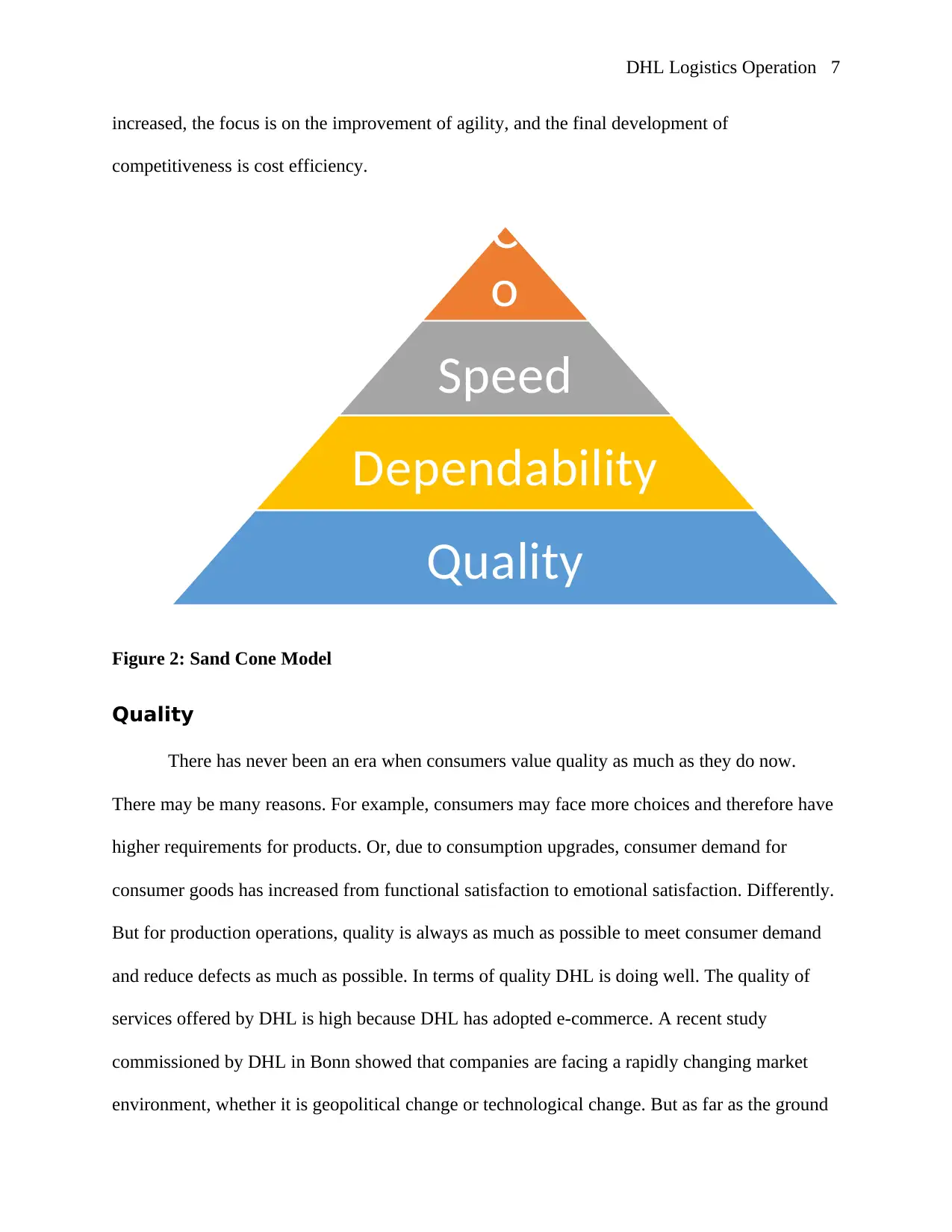
DHL Logistics Operation 7
increased, the focus is on the improvement of agility, and the final development of
competitiveness is cost efficiency.
Figure 2: Sand Cone Model
Quality
There has never been an era when consumers value quality as much as they do now.
There may be many reasons. For example, consumers may face more choices and therefore have
higher requirements for products. Or, due to consumption upgrades, consumer demand for
consumer goods has increased from functional satisfaction to emotional satisfaction. Differently.
But for production operations, quality is always as much as possible to meet consumer demand
and reduce defects as much as possible. In terms of quality DHL is doing well. The quality of
services offered by DHL is high because DHL has adopted e-commerce. A recent study
commissioned by DHL in Bonn showed that companies are facing a rapidly changing market
environment, whether it is geopolitical change or technological change. But as far as the ground
C
o
st
Speed
Dependability
Quality
increased, the focus is on the improvement of agility, and the final development of
competitiveness is cost efficiency.
Figure 2: Sand Cone Model
Quality
There has never been an era when consumers value quality as much as they do now.
There may be many reasons. For example, consumers may face more choices and therefore have
higher requirements for products. Or, due to consumption upgrades, consumer demand for
consumer goods has increased from functional satisfaction to emotional satisfaction. Differently.
But for production operations, quality is always as much as possible to meet consumer demand
and reduce defects as much as possible. In terms of quality DHL is doing well. The quality of
services offered by DHL is high because DHL has adopted e-commerce. A recent study
commissioned by DHL in Bonn showed that companies are facing a rapidly changing market
environment, whether it is geopolitical change or technological change. But as far as the ground
C
o
st
Speed
Dependability
Quality
Paraphrase This Document
Need a fresh take? Get an instant paraphrase of this document with our AI Paraphraser

DHL Logistics Operation 8
transportation business is concerned, the biggest concern of enterprises so far is the e-commerce
itself and its impact on service and ground transportation requirements. The high customer
service expectations generated by e-commerce are affecting businesses. For example, customers
want same-day or next-day delivery, expect a variety of last-mile delivery options, high shipping
visibility, and flexible or free return policies and ample inventory. Services are becoming
increasingly challenging (Deutsche Post DHL Group 2019).
Dependability
This is another key performing indicator proposed by sand cone model. Reliability
reflects whether you can keep your promise to customers as always. During production and
operation, various situations may be encountered, such as problems with municipal water supply
and power supply, serious equipment failures, national holidays, etc., which will affect
production and ultimately reach the commitment of customers. A typical example is that one
month before the Spring Festival each year, due to promotions, strong demand and other factors,
it will cause ultra-high demand for the month. In extreme cases, it can go to twice the average
monthly demand. In this case, there will be huge challenges to reliability, such as manpower
requirements. DHL has high level of dependability. DHL, the world's leading express and
logistics company, is piloting a range of new technologies in the US business (Deutsche Post
DHL Group 2019). As consumer expectations grow rapidly, logistics providers are facing the
challenge of providing more flexible and efficient services due to some major trends including e-
commerce, urbanization and sustainability (Sainathan, 2013). DHL actively responds to
changing market demands by introducing new technologies in its US operations. These includes
the use of advanced business modeling techniques to evaluate the accuracy of inventory
strategies, lead times and transportation changes. Effect; consider the impact of various aspects
transportation business is concerned, the biggest concern of enterprises so far is the e-commerce
itself and its impact on service and ground transportation requirements. The high customer
service expectations generated by e-commerce are affecting businesses. For example, customers
want same-day or next-day delivery, expect a variety of last-mile delivery options, high shipping
visibility, and flexible or free return policies and ample inventory. Services are becoming
increasingly challenging (Deutsche Post DHL Group 2019).
Dependability
This is another key performing indicator proposed by sand cone model. Reliability
reflects whether you can keep your promise to customers as always. During production and
operation, various situations may be encountered, such as problems with municipal water supply
and power supply, serious equipment failures, national holidays, etc., which will affect
production and ultimately reach the commitment of customers. A typical example is that one
month before the Spring Festival each year, due to promotions, strong demand and other factors,
it will cause ultra-high demand for the month. In extreme cases, it can go to twice the average
monthly demand. In this case, there will be huge challenges to reliability, such as manpower
requirements. DHL has high level of dependability. DHL, the world's leading express and
logistics company, is piloting a range of new technologies in the US business (Deutsche Post
DHL Group 2019). As consumer expectations grow rapidly, logistics providers are facing the
challenge of providing more flexible and efficient services due to some major trends including e-
commerce, urbanization and sustainability (Sainathan, 2013). DHL actively responds to
changing market demands by introducing new technologies in its US operations. These includes
the use of advanced business modeling techniques to evaluate the accuracy of inventory
strategies, lead times and transportation changes. Effect; consider the impact of various aspects
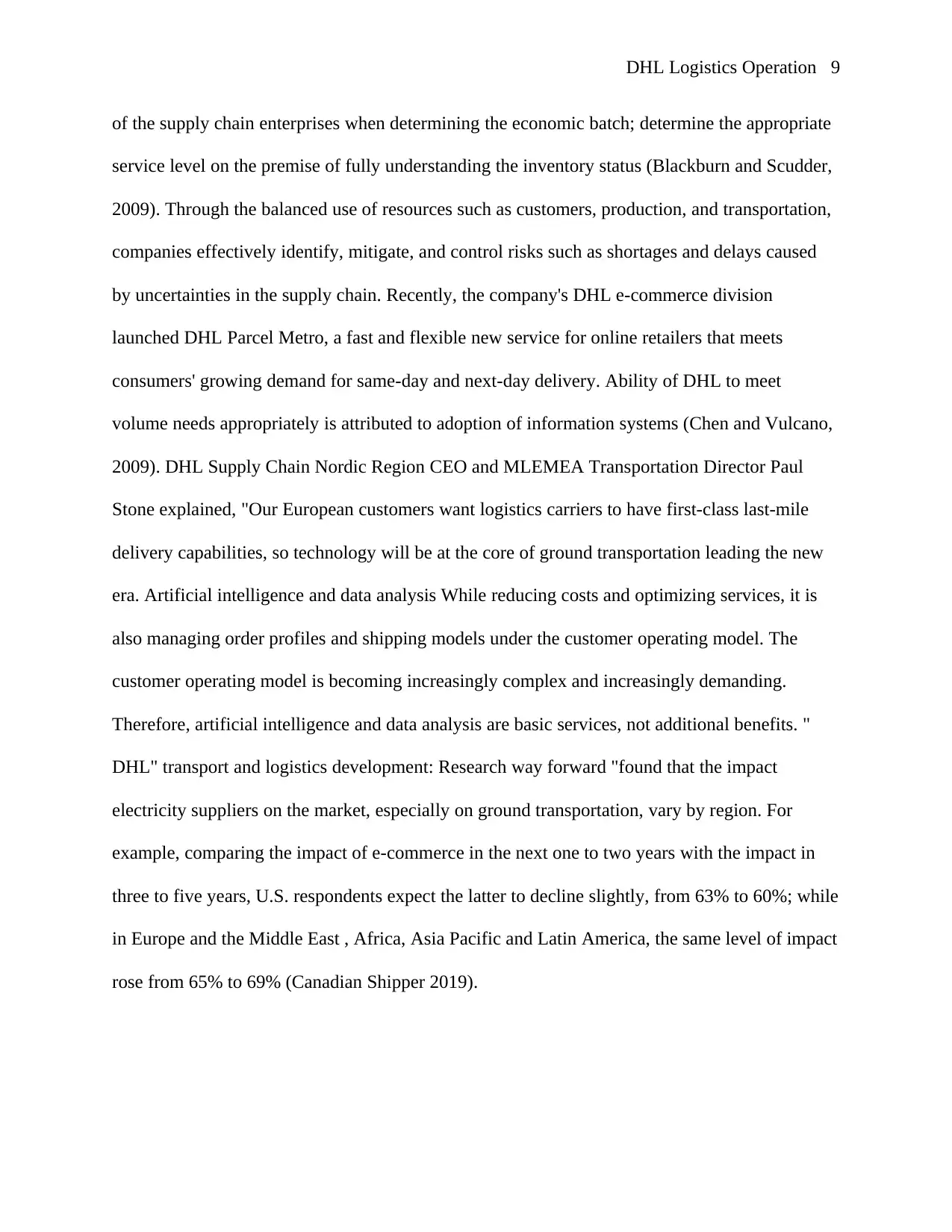
DHL Logistics Operation 9
of the supply chain enterprises when determining the economic batch; determine the appropriate
service level on the premise of fully understanding the inventory status (Blackburn and Scudder,
2009). Through the balanced use of resources such as customers, production, and transportation,
companies effectively identify, mitigate, and control risks such as shortages and delays caused
by uncertainties in the supply chain. Recently, the company's DHL e-commerce division
launched DHL Parcel Metro, a fast and flexible new service for online retailers that meets
consumers' growing demand for same-day and next-day delivery. Ability of DHL to meet
volume needs appropriately is attributed to adoption of information systems (Chen and Vulcano,
2009). DHL Supply Chain Nordic Region CEO and MLEMEA Transportation Director Paul
Stone explained, "Our European customers want logistics carriers to have first-class last-mile
delivery capabilities, so technology will be at the core of ground transportation leading the new
era. Artificial intelligence and data analysis While reducing costs and optimizing services, it is
also managing order profiles and shipping models under the customer operating model. The
customer operating model is becoming increasingly complex and increasingly demanding.
Therefore, artificial intelligence and data analysis are basic services, not additional benefits. "
DHL" transport and logistics development: Research way forward "found that the impact
electricity suppliers on the market, especially on ground transportation, vary by region. For
example, comparing the impact of e-commerce in the next one to two years with the impact in
three to five years, U.S. respondents expect the latter to decline slightly, from 63% to 60%; while
in Europe and the Middle East , Africa, Asia Pacific and Latin America, the same level of impact
rose from 65% to 69% (Canadian Shipper 2019).
of the supply chain enterprises when determining the economic batch; determine the appropriate
service level on the premise of fully understanding the inventory status (Blackburn and Scudder,
2009). Through the balanced use of resources such as customers, production, and transportation,
companies effectively identify, mitigate, and control risks such as shortages and delays caused
by uncertainties in the supply chain. Recently, the company's DHL e-commerce division
launched DHL Parcel Metro, a fast and flexible new service for online retailers that meets
consumers' growing demand for same-day and next-day delivery. Ability of DHL to meet
volume needs appropriately is attributed to adoption of information systems (Chen and Vulcano,
2009). DHL Supply Chain Nordic Region CEO and MLEMEA Transportation Director Paul
Stone explained, "Our European customers want logistics carriers to have first-class last-mile
delivery capabilities, so technology will be at the core of ground transportation leading the new
era. Artificial intelligence and data analysis While reducing costs and optimizing services, it is
also managing order profiles and shipping models under the customer operating model. The
customer operating model is becoming increasingly complex and increasingly demanding.
Therefore, artificial intelligence and data analysis are basic services, not additional benefits. "
DHL" transport and logistics development: Research way forward "found that the impact
electricity suppliers on the market, especially on ground transportation, vary by region. For
example, comparing the impact of e-commerce in the next one to two years with the impact in
three to five years, U.S. respondents expect the latter to decline slightly, from 63% to 60%; while
in Europe and the Middle East , Africa, Asia Pacific and Latin America, the same level of impact
rose from 65% to 69% (Canadian Shipper 2019).
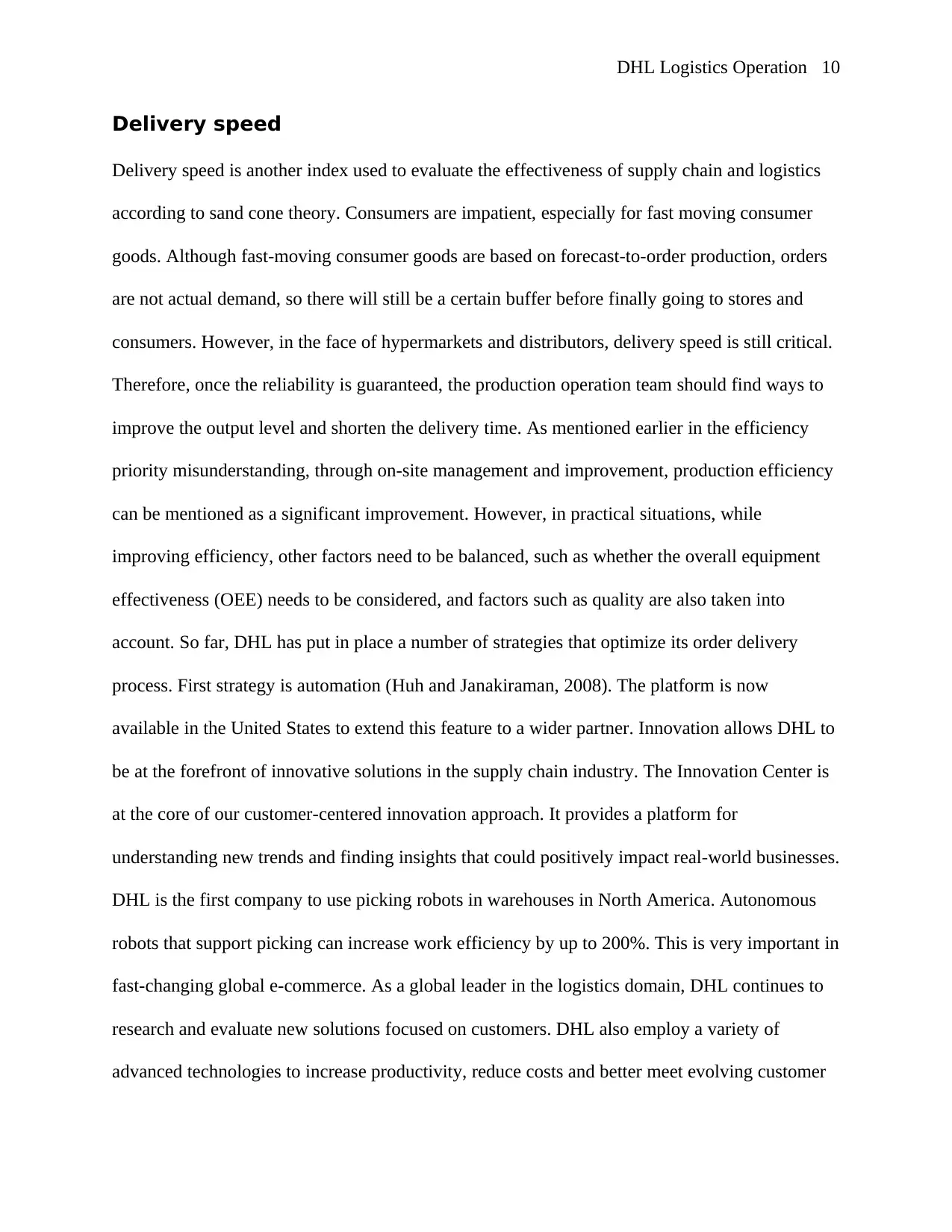
DHL Logistics Operation 10
Delivery speed
Delivery speed is another index used to evaluate the effectiveness of supply chain and logistics
according to sand cone theory. Consumers are impatient, especially for fast moving consumer
goods. Although fast-moving consumer goods are based on forecast-to-order production, orders
are not actual demand, so there will still be a certain buffer before finally going to stores and
consumers. However, in the face of hypermarkets and distributors, delivery speed is still critical.
Therefore, once the reliability is guaranteed, the production operation team should find ways to
improve the output level and shorten the delivery time. As mentioned earlier in the efficiency
priority misunderstanding, through on-site management and improvement, production efficiency
can be mentioned as a significant improvement. However, in practical situations, while
improving efficiency, other factors need to be balanced, such as whether the overall equipment
effectiveness (OEE) needs to be considered, and factors such as quality are also taken into
account. So far, DHL has put in place a number of strategies that optimize its order delivery
process. First strategy is automation (Huh and Janakiraman, 2008). The platform is now
available in the United States to extend this feature to a wider partner. Innovation allows DHL to
be at the forefront of innovative solutions in the supply chain industry. The Innovation Center is
at the core of our customer-centered innovation approach. It provides a platform for
understanding new trends and finding insights that could positively impact real-world businesses.
DHL is the first company to use picking robots in warehouses in North America. Autonomous
robots that support picking can increase work efficiency by up to 200%. This is very important in
fast-changing global e-commerce. As a global leader in the logistics domain, DHL continues to
research and evaluate new solutions focused on customers. DHL also employ a variety of
advanced technologies to increase productivity, reduce costs and better meet evolving customer
Delivery speed
Delivery speed is another index used to evaluate the effectiveness of supply chain and logistics
according to sand cone theory. Consumers are impatient, especially for fast moving consumer
goods. Although fast-moving consumer goods are based on forecast-to-order production, orders
are not actual demand, so there will still be a certain buffer before finally going to stores and
consumers. However, in the face of hypermarkets and distributors, delivery speed is still critical.
Therefore, once the reliability is guaranteed, the production operation team should find ways to
improve the output level and shorten the delivery time. As mentioned earlier in the efficiency
priority misunderstanding, through on-site management and improvement, production efficiency
can be mentioned as a significant improvement. However, in practical situations, while
improving efficiency, other factors need to be balanced, such as whether the overall equipment
effectiveness (OEE) needs to be considered, and factors such as quality are also taken into
account. So far, DHL has put in place a number of strategies that optimize its order delivery
process. First strategy is automation (Huh and Janakiraman, 2008). The platform is now
available in the United States to extend this feature to a wider partner. Innovation allows DHL to
be at the forefront of innovative solutions in the supply chain industry. The Innovation Center is
at the core of our customer-centered innovation approach. It provides a platform for
understanding new trends and finding insights that could positively impact real-world businesses.
DHL is the first company to use picking robots in warehouses in North America. Autonomous
robots that support picking can increase work efficiency by up to 200%. This is very important in
fast-changing global e-commerce. As a global leader in the logistics domain, DHL continues to
research and evaluate new solutions focused on customers. DHL also employ a variety of
advanced technologies to increase productivity, reduce costs and better meet evolving customer
Secure Best Marks with AI Grader
Need help grading? Try our AI Grader for instant feedback on your assignments.
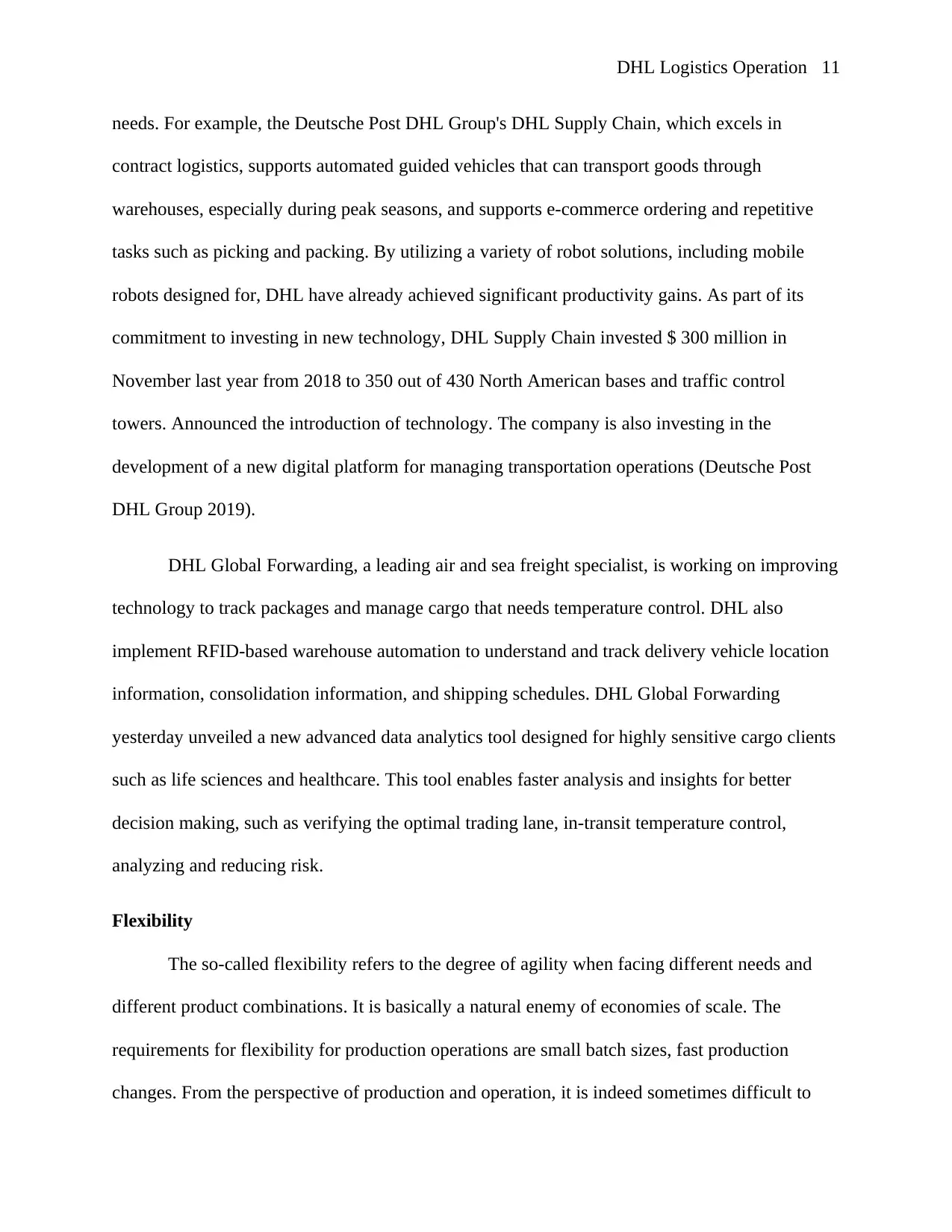
DHL Logistics Operation 11
needs. For example, the Deutsche Post DHL Group's DHL Supply Chain, which excels in
contract logistics, supports automated guided vehicles that can transport goods through
warehouses, especially during peak seasons, and supports e-commerce ordering and repetitive
tasks such as picking and packing. By utilizing a variety of robot solutions, including mobile
robots designed for, DHL have already achieved significant productivity gains. As part of its
commitment to investing in new technology, DHL Supply Chain invested $ 300 million in
November last year from 2018 to 350 out of 430 North American bases and traffic control
towers. Announced the introduction of technology. The company is also investing in the
development of a new digital platform for managing transportation operations (Deutsche Post
DHL Group 2019).
DHL Global Forwarding, a leading air and sea freight specialist, is working on improving
technology to track packages and manage cargo that needs temperature control. DHL also
implement RFID-based warehouse automation to understand and track delivery vehicle location
information, consolidation information, and shipping schedules. DHL Global Forwarding
yesterday unveiled a new advanced data analytics tool designed for highly sensitive cargo clients
such as life sciences and healthcare. This tool enables faster analysis and insights for better
decision making, such as verifying the optimal trading lane, in-transit temperature control,
analyzing and reducing risk.
Flexibility
The so-called flexibility refers to the degree of agility when facing different needs and
different product combinations. It is basically a natural enemy of economies of scale. The
requirements for flexibility for production operations are small batch sizes, fast production
changes. From the perspective of production and operation, it is indeed sometimes difficult to
needs. For example, the Deutsche Post DHL Group's DHL Supply Chain, which excels in
contract logistics, supports automated guided vehicles that can transport goods through
warehouses, especially during peak seasons, and supports e-commerce ordering and repetitive
tasks such as picking and packing. By utilizing a variety of robot solutions, including mobile
robots designed for, DHL have already achieved significant productivity gains. As part of its
commitment to investing in new technology, DHL Supply Chain invested $ 300 million in
November last year from 2018 to 350 out of 430 North American bases and traffic control
towers. Announced the introduction of technology. The company is also investing in the
development of a new digital platform for managing transportation operations (Deutsche Post
DHL Group 2019).
DHL Global Forwarding, a leading air and sea freight specialist, is working on improving
technology to track packages and manage cargo that needs temperature control. DHL also
implement RFID-based warehouse automation to understand and track delivery vehicle location
information, consolidation information, and shipping schedules. DHL Global Forwarding
yesterday unveiled a new advanced data analytics tool designed for highly sensitive cargo clients
such as life sciences and healthcare. This tool enables faster analysis and insights for better
decision making, such as verifying the optimal trading lane, in-transit temperature control,
analyzing and reducing risk.
Flexibility
The so-called flexibility refers to the degree of agility when facing different needs and
different product combinations. It is basically a natural enemy of economies of scale. The
requirements for flexibility for production operations are small batch sizes, fast production
changes. From the perspective of production and operation, it is indeed sometimes difficult to
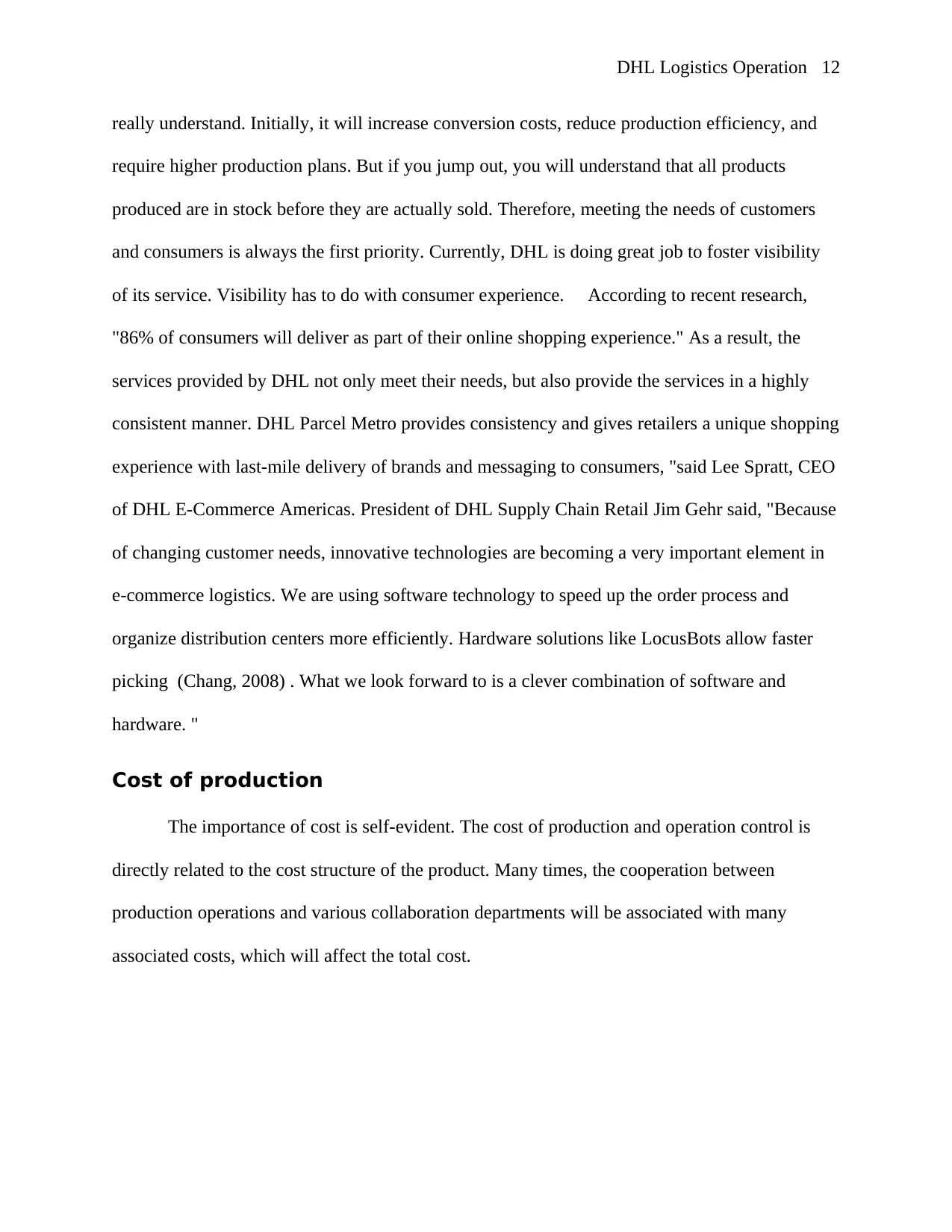
DHL Logistics Operation 12
really understand. Initially, it will increase conversion costs, reduce production efficiency, and
require higher production plans. But if you jump out, you will understand that all products
produced are in stock before they are actually sold. Therefore, meeting the needs of customers
and consumers is always the first priority. Currently, DHL is doing great job to foster visibility
of its service. Visibility has to do with consumer experience. According to recent research,
"86% of consumers will deliver as part of their online shopping experience." As a result, the
services provided by DHL not only meet their needs, but also provide the services in a highly
consistent manner. DHL Parcel Metro provides consistency and gives retailers a unique shopping
experience with last-mile delivery of brands and messaging to consumers, "said Lee Spratt, CEO
of DHL E-Commerce Americas. President of DHL Supply Chain Retail Jim Gehr said, "Because
of changing customer needs, innovative technologies are becoming a very important element in
e-commerce logistics. We are using software technology to speed up the order process and
organize distribution centers more efficiently. Hardware solutions like LocusBots allow faster
picking (Chang, 2008) . What we look forward to is a clever combination of software and
hardware. "
Cost of production
The importance of cost is self-evident. The cost of production and operation control is
directly related to the cost structure of the product. Many times, the cooperation between
production operations and various collaboration departments will be associated with many
associated costs, which will affect the total cost.
really understand. Initially, it will increase conversion costs, reduce production efficiency, and
require higher production plans. But if you jump out, you will understand that all products
produced are in stock before they are actually sold. Therefore, meeting the needs of customers
and consumers is always the first priority. Currently, DHL is doing great job to foster visibility
of its service. Visibility has to do with consumer experience. According to recent research,
"86% of consumers will deliver as part of their online shopping experience." As a result, the
services provided by DHL not only meet their needs, but also provide the services in a highly
consistent manner. DHL Parcel Metro provides consistency and gives retailers a unique shopping
experience with last-mile delivery of brands and messaging to consumers, "said Lee Spratt, CEO
of DHL E-Commerce Americas. President of DHL Supply Chain Retail Jim Gehr said, "Because
of changing customer needs, innovative technologies are becoming a very important element in
e-commerce logistics. We are using software technology to speed up the order process and
organize distribution centers more efficiently. Hardware solutions like LocusBots allow faster
picking (Chang, 2008) . What we look forward to is a clever combination of software and
hardware. "
Cost of production
The importance of cost is self-evident. The cost of production and operation control is
directly related to the cost structure of the product. Many times, the cooperation between
production operations and various collaboration departments will be associated with many
associated costs, which will affect the total cost.
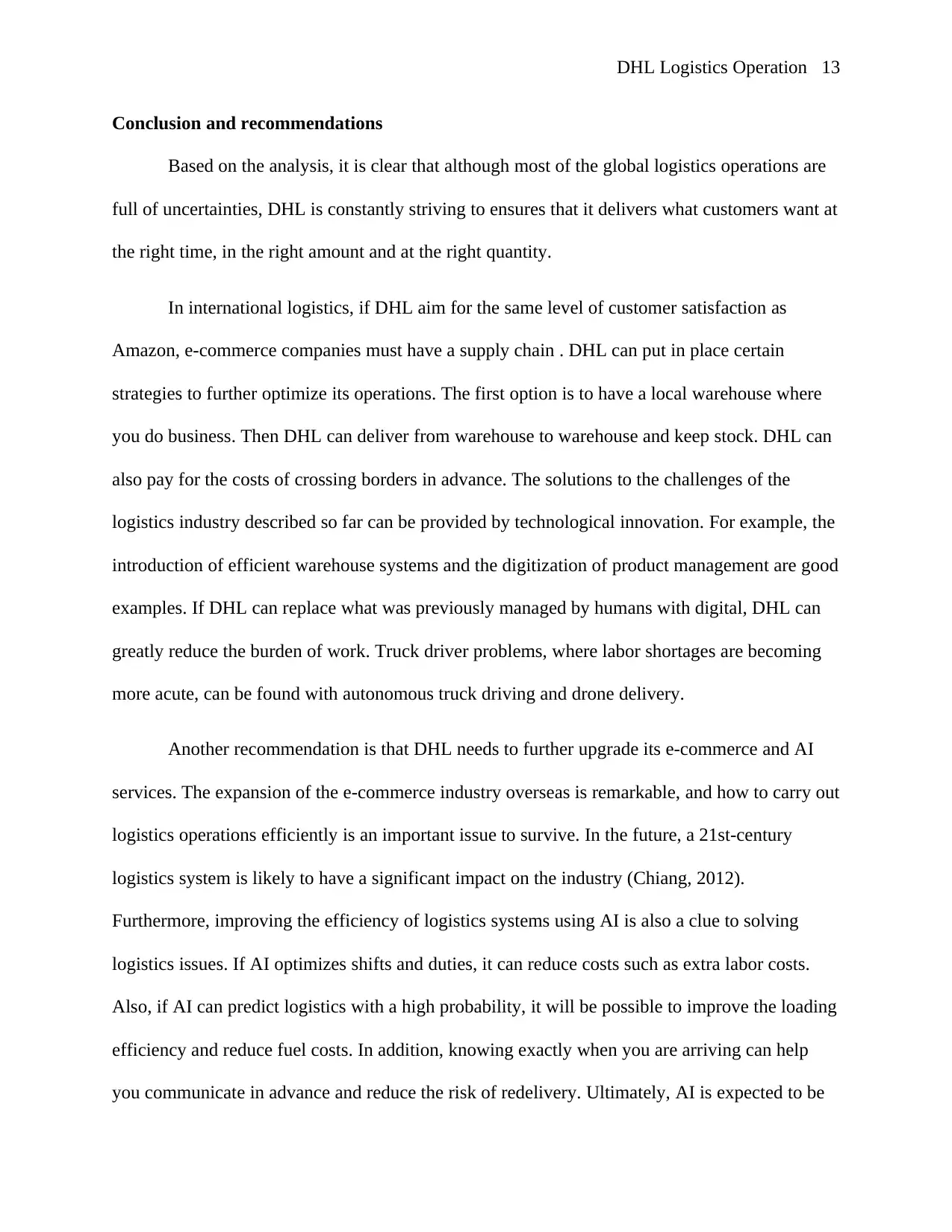
DHL Logistics Operation 13
Conclusion and recommendations
Based on the analysis, it is clear that although most of the global logistics operations are
full of uncertainties, DHL is constantly striving to ensures that it delivers what customers want at
the right time, in the right amount and at the right quantity.
In international logistics, if DHL aim for the same level of customer satisfaction as
Amazon, e-commerce companies must have a supply chain . DHL can put in place certain
strategies to further optimize its operations. The first option is to have a local warehouse where
you do business. Then DHL can deliver from warehouse to warehouse and keep stock. DHL can
also pay for the costs of crossing borders in advance. The solutions to the challenges of the
logistics industry described so far can be provided by technological innovation. For example, the
introduction of efficient warehouse systems and the digitization of product management are good
examples. If DHL can replace what was previously managed by humans with digital, DHL can
greatly reduce the burden of work. Truck driver problems, where labor shortages are becoming
more acute, can be found with autonomous truck driving and drone delivery.
Another recommendation is that DHL needs to further upgrade its e-commerce and AI
services. The expansion of the e-commerce industry overseas is remarkable, and how to carry out
logistics operations efficiently is an important issue to survive. In the future, a 21st-century
logistics system is likely to have a significant impact on the industry (Chiang, 2012).
Furthermore, improving the efficiency of logistics systems using AI is also a clue to solving
logistics issues. If AI optimizes shifts and duties, it can reduce costs such as extra labor costs.
Also, if AI can predict logistics with a high probability, it will be possible to improve the loading
efficiency and reduce fuel costs. In addition, knowing exactly when you are arriving can help
you communicate in advance and reduce the risk of redelivery. Ultimately, AI is expected to be
Conclusion and recommendations
Based on the analysis, it is clear that although most of the global logistics operations are
full of uncertainties, DHL is constantly striving to ensures that it delivers what customers want at
the right time, in the right amount and at the right quantity.
In international logistics, if DHL aim for the same level of customer satisfaction as
Amazon, e-commerce companies must have a supply chain . DHL can put in place certain
strategies to further optimize its operations. The first option is to have a local warehouse where
you do business. Then DHL can deliver from warehouse to warehouse and keep stock. DHL can
also pay for the costs of crossing borders in advance. The solutions to the challenges of the
logistics industry described so far can be provided by technological innovation. For example, the
introduction of efficient warehouse systems and the digitization of product management are good
examples. If DHL can replace what was previously managed by humans with digital, DHL can
greatly reduce the burden of work. Truck driver problems, where labor shortages are becoming
more acute, can be found with autonomous truck driving and drone delivery.
Another recommendation is that DHL needs to further upgrade its e-commerce and AI
services. The expansion of the e-commerce industry overseas is remarkable, and how to carry out
logistics operations efficiently is an important issue to survive. In the future, a 21st-century
logistics system is likely to have a significant impact on the industry (Chiang, 2012).
Furthermore, improving the efficiency of logistics systems using AI is also a clue to solving
logistics issues. If AI optimizes shifts and duties, it can reduce costs such as extra labor costs.
Also, if AI can predict logistics with a high probability, it will be possible to improve the loading
efficiency and reduce fuel costs. In addition, knowing exactly when you are arriving can help
you communicate in advance and reduce the risk of redelivery. Ultimately, AI is expected to be
Paraphrase This Document
Need a fresh take? Get an instant paraphrase of this document with our AI Paraphraser
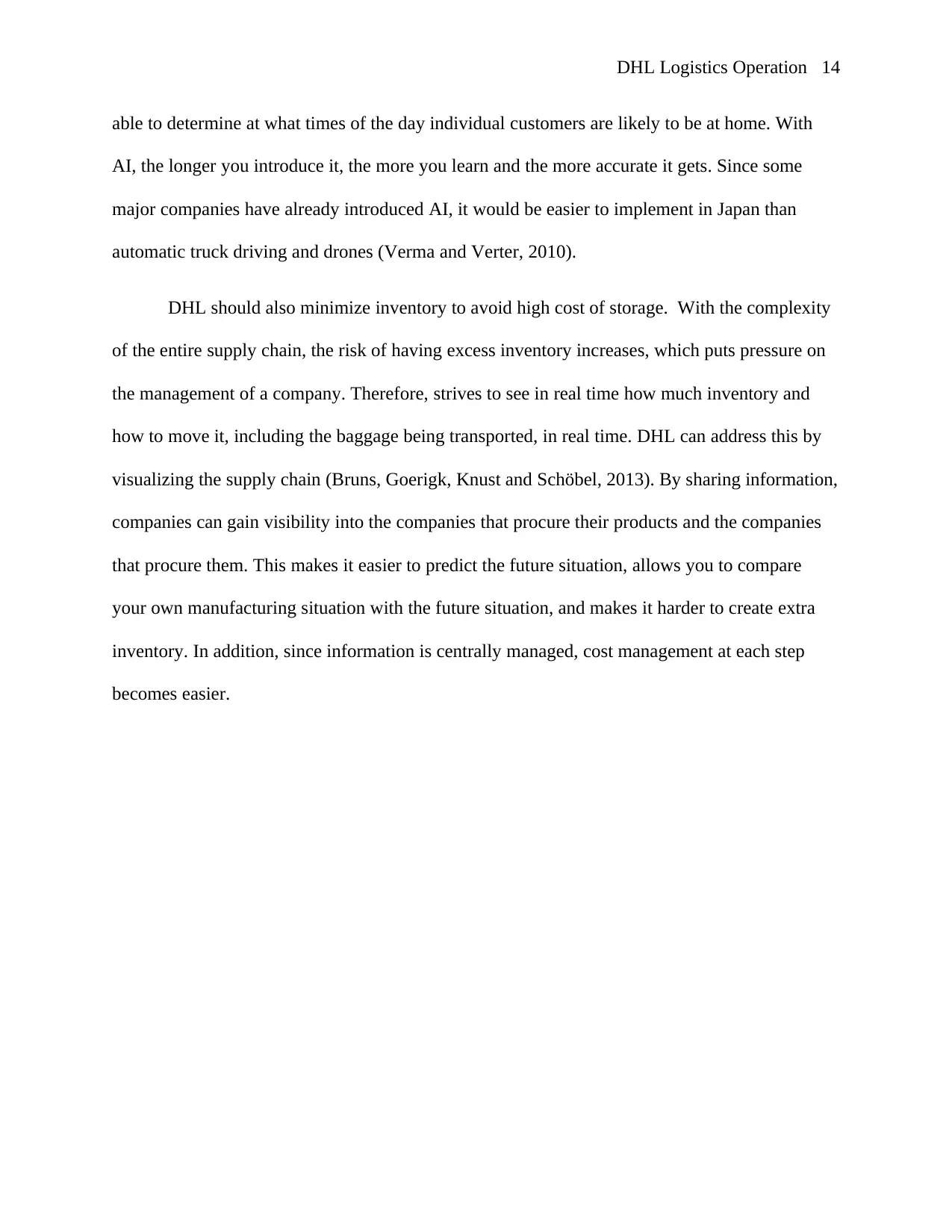
DHL Logistics Operation 14
able to determine at what times of the day individual customers are likely to be at home. With
AI, the longer you introduce it, the more you learn and the more accurate it gets. Since some
major companies have already introduced AI, it would be easier to implement in Japan than
automatic truck driving and drones (Verma and Verter, 2010).
DHL should also minimize inventory to avoid high cost of storage. With the complexity
of the entire supply chain, the risk of having excess inventory increases, which puts pressure on
the management of a company. Therefore, strives to see in real time how much inventory and
how to move it, including the baggage being transported, in real time. DHL can address this by
visualizing the supply chain (Bruns, Goerigk, Knust and Schöbel, 2013). By sharing information,
companies can gain visibility into the companies that procure their products and the companies
that procure them. This makes it easier to predict the future situation, allows you to compare
your own manufacturing situation with the future situation, and makes it harder to create extra
inventory. In addition, since information is centrally managed, cost management at each step
becomes easier.
able to determine at what times of the day individual customers are likely to be at home. With
AI, the longer you introduce it, the more you learn and the more accurate it gets. Since some
major companies have already introduced AI, it would be easier to implement in Japan than
automatic truck driving and drones (Verma and Verter, 2010).
DHL should also minimize inventory to avoid high cost of storage. With the complexity
of the entire supply chain, the risk of having excess inventory increases, which puts pressure on
the management of a company. Therefore, strives to see in real time how much inventory and
how to move it, including the baggage being transported, in real time. DHL can address this by
visualizing the supply chain (Bruns, Goerigk, Knust and Schöbel, 2013). By sharing information,
companies can gain visibility into the companies that procure their products and the companies
that procure them. This makes it easier to predict the future situation, allows you to compare
your own manufacturing situation with the future situation, and makes it harder to create extra
inventory. In addition, since information is centrally managed, cost management at each step
becomes easier.

DHL Logistics Operation 15
List of References
Blackburn, J. and Scudder, G. (2009). “Supply chain strategies for perishable products: the case
of fresh produce,” Production and Operations Management, vol. 18, no. 2, pp. 129–137
Bruns, F., Goerigk, M., Knust, S. and Schöbel, A. (2013). “Robust load planning of trains in
intermodal transportation,” OR Spectrum, vol. 1, pp. 1–38.
Brynjolfsson, E. Hu, Y. and Rahman, M. S. (2009). “Battle of the retail channels: how product
selection and geography drive cross-channel competition,” Management Science, vol. 55, no. 11,
pp. 1755–1765
Canadian Shipper (2019). e-commerce impacts will shape transport strategies: DHL. Retrieved
from: https://www.canadianshipper.com/transportation-and-logistics/e-commerce-impacts-will-
shape-transport-strategies-dhl/1003380311/
Chang, T. S. (2008). “Best routes selection in international intermodal networks,” Computers
and Operations Research, vol. 35, no. 9, pp. 2877–2891.
Chen Y. J. and Vulcano, G. (2009). “Effects of information disclosure under first- and second-
price auctions in a supply chain setting,” Manufacturing and Service Operations Management,
vol. 11, no. 2, pp. 299–316.
Chiang, W. K. (2012). “Supply chain dynamics and channel efficiency in durable product pricing
and distribution,” Manufacturing and Service Operations Management, vol. 14, no. 2, pp. 327–
343.
List of References
Blackburn, J. and Scudder, G. (2009). “Supply chain strategies for perishable products: the case
of fresh produce,” Production and Operations Management, vol. 18, no. 2, pp. 129–137
Bruns, F., Goerigk, M., Knust, S. and Schöbel, A. (2013). “Robust load planning of trains in
intermodal transportation,” OR Spectrum, vol. 1, pp. 1–38.
Brynjolfsson, E. Hu, Y. and Rahman, M. S. (2009). “Battle of the retail channels: how product
selection and geography drive cross-channel competition,” Management Science, vol. 55, no. 11,
pp. 1755–1765
Canadian Shipper (2019). e-commerce impacts will shape transport strategies: DHL. Retrieved
from: https://www.canadianshipper.com/transportation-and-logistics/e-commerce-impacts-will-
shape-transport-strategies-dhl/1003380311/
Chang, T. S. (2008). “Best routes selection in international intermodal networks,” Computers
and Operations Research, vol. 35, no. 9, pp. 2877–2891.
Chen Y. J. and Vulcano, G. (2009). “Effects of information disclosure under first- and second-
price auctions in a supply chain setting,” Manufacturing and Service Operations Management,
vol. 11, no. 2, pp. 299–316.
Chiang, W. K. (2012). “Supply chain dynamics and channel efficiency in durable product pricing
and distribution,” Manufacturing and Service Operations Management, vol. 14, no. 2, pp. 327–
343.
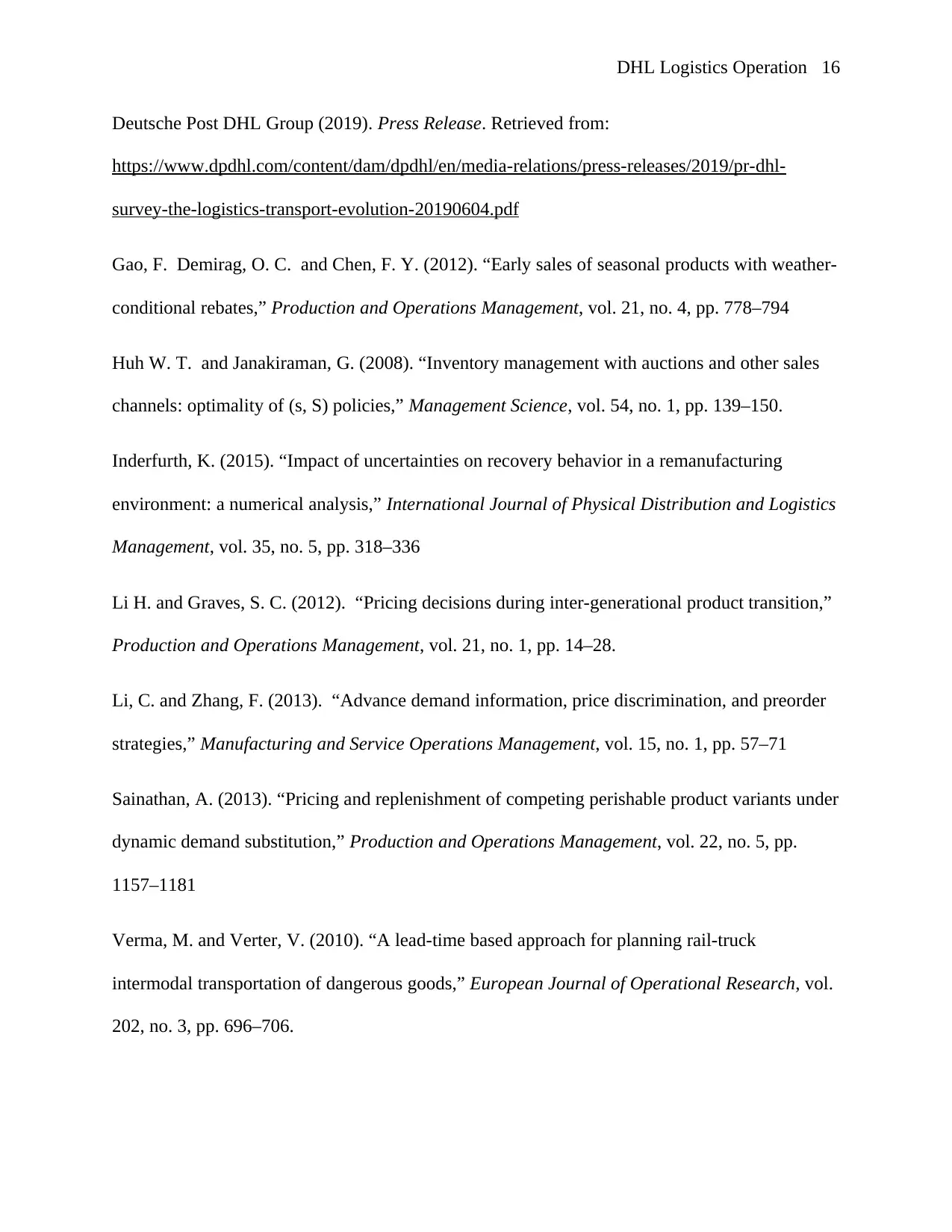
DHL Logistics Operation 16
Deutsche Post DHL Group (2019). Press Release. Retrieved from:
https://www.dpdhl.com/content/dam/dpdhl/en/media-relations/press-releases/2019/pr-dhl-
survey-the-logistics-transport-evolution-20190604.pdf
Gao, F. Demirag, O. C. and Chen, F. Y. (2012). “Early sales of seasonal products with weather-
conditional rebates,” Production and Operations Management, vol. 21, no. 4, pp. 778–794
Huh W. T. and Janakiraman, G. (2008). “Inventory management with auctions and other sales
channels: optimality of (s, S) policies,” Management Science, vol. 54, no. 1, pp. 139–150.
Inderfurth, K. (2015). “Impact of uncertainties on recovery behavior in a remanufacturing
environment: a numerical analysis,” International Journal of Physical Distribution and Logistics
Management, vol. 35, no. 5, pp. 318–336
Li H. and Graves, S. C. (2012). “Pricing decisions during inter-generational product transition,”
Production and Operations Management, vol. 21, no. 1, pp. 14–28.
Li, C. and Zhang, F. (2013). “Advance demand information, price discrimination, and preorder
strategies,” Manufacturing and Service Operations Management, vol. 15, no. 1, pp. 57–71
Sainathan, A. (2013). “Pricing and replenishment of competing perishable product variants under
dynamic demand substitution,” Production and Operations Management, vol. 22, no. 5, pp.
1157–1181
Verma, M. and Verter, V. (2010). “A lead-time based approach for planning rail-truck
intermodal transportation of dangerous goods,” European Journal of Operational Research, vol.
202, no. 3, pp. 696–706.
Deutsche Post DHL Group (2019). Press Release. Retrieved from:
https://www.dpdhl.com/content/dam/dpdhl/en/media-relations/press-releases/2019/pr-dhl-
survey-the-logistics-transport-evolution-20190604.pdf
Gao, F. Demirag, O. C. and Chen, F. Y. (2012). “Early sales of seasonal products with weather-
conditional rebates,” Production and Operations Management, vol. 21, no. 4, pp. 778–794
Huh W. T. and Janakiraman, G. (2008). “Inventory management with auctions and other sales
channels: optimality of (s, S) policies,” Management Science, vol. 54, no. 1, pp. 139–150.
Inderfurth, K. (2015). “Impact of uncertainties on recovery behavior in a remanufacturing
environment: a numerical analysis,” International Journal of Physical Distribution and Logistics
Management, vol. 35, no. 5, pp. 318–336
Li H. and Graves, S. C. (2012). “Pricing decisions during inter-generational product transition,”
Production and Operations Management, vol. 21, no. 1, pp. 14–28.
Li, C. and Zhang, F. (2013). “Advance demand information, price discrimination, and preorder
strategies,” Manufacturing and Service Operations Management, vol. 15, no. 1, pp. 57–71
Sainathan, A. (2013). “Pricing and replenishment of competing perishable product variants under
dynamic demand substitution,” Production and Operations Management, vol. 22, no. 5, pp.
1157–1181
Verma, M. and Verter, V. (2010). “A lead-time based approach for planning rail-truck
intermodal transportation of dangerous goods,” European Journal of Operational Research, vol.
202, no. 3, pp. 696–706.
Secure Best Marks with AI Grader
Need help grading? Try our AI Grader for instant feedback on your assignments.

DHL Logistics Operation 17
Deutsche Post DHL Group (2019). Delivering Tomorrow. Logistics 2050 A Scenario Study.
Retrieved from: https://www.dhl.com/content/dam/Local_Images/g0/aboutus/SpecialInterest/
Logistics2050/szenario_study_logistics_2050.pdf
Deutsche Post DHL Group (2019). Delivering Tomorrow. Logistics 2050 A Scenario Study.
Retrieved from: https://www.dhl.com/content/dam/Local_Images/g0/aboutus/SpecialInterest/
Logistics2050/szenario_study_logistics_2050.pdf
1 out of 17
Your All-in-One AI-Powered Toolkit for Academic Success.
+13062052269
info@desklib.com
Available 24*7 on WhatsApp / Email
![[object Object]](/_next/static/media/star-bottom.7253800d.svg)
Unlock your academic potential
© 2024 | Zucol Services PVT LTD | All rights reserved.



